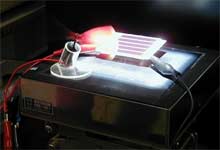Blackberries, blueberries, oranges and grapes—chemistry students at Rowan University (Glassboro, N.J.) are loading up on their fruits these days, but it has nothing to do with the food pyramid.
The students (John Manganaro, 21, a senior chemistry major from Monroeville; Dave Lawrence, 23, a junior chemistry and physics major from Jackson; Anthony Antonelli, 21, a senior chemistry and biochemistry major from Bellmawr; and Bill Green, 22, a senior chemistry major from Port Norris) are using the fruit to produce solar energy.
Actually, they are using the dye from the fruit in a process to create solar cells, under the guidance of Dr. Darius Kuciauskas, an assistant professor of chemistry.
Currently, commercially available solar cells are efficient and robust but expensive, according to the team.
“To develop efficient—and most importantly inexpensive—solar cells, scientists are following the design of photosynthetic systems,” the professor said. “Research on so-called ‘third-generation’ solar cells is being carried out at Rowan University.”
He explained that commercially available solar cells—such as the ones people can put on their roofs— are “first generation” solar cells. They are based on crystalline silicon, the same material from which computer chips are made, and they are expensive. “Second-generation” solar cells are also based on crystalline semiconductors, but use only thin films of the expensive material. “Third-generation” solar cells are still in the research stage and some years away from wide commercial use. There are several different solar cell designs under this umbrella, including Rowan’s “dye-sensitized solar cells,” which were invented by a chemist in Switzerland. The common idea of the “third-generation” field is to use inexpensive material—like paint—but to assemble that material into well-defined biomimetic structures, structures that are manmade but mimic nature.
The Rowan researchers are working to refine a process in which they extract dye from a range of fruit and blend it into a kind of scientific “smoothie.” They separate out the heavy particles using filters and a centrifuge to obtain a liquid, which they freeze dry. The process leaves the researchers with sugar and a dye. They separate the components and obtain pure, brightly colored dyes in an acidic solution.
“We completely developed this process ourselves,” said Manganaro.
From there, they place the dye on a conductive glass coated with a porous film of titanium dioxide—a material found in everything from toothpaste to sandwich cookies to white paint—which bonds the dye to the glass. Finally, they add iodine and potassium iodide electrolyte for dye regeneration.
When light hits the processed fruit dye on the glass, it “excites” the electrons, which mobilizes or “frees” them. The electrons travel to a conductive glass electrode. That, in turn, produces electricity.
“There’s less output from these organic solar cells than a traditional silicon cell,” admitted Green, but the production from fruit is “dirt cheap.” While similar work has been done, the extraction process is new, to the best of the team’s knowledge.
“You can make the components from store-bought items,” Lawrence said.
Added Antonelli, “Construction of the cells is so simple and inexpensive that anyone can build his or her own given fruit, white paint, iodine and glass.”
“This project was completed as a part of a chemistry laboratory course,” Kuciauskas said. “Students who continue this work will attempt to develop better light-harvesting dyes by assembling larger aggregates of photosynthetic pigments. Such a biomimetic approach is based on green plants and photosynthetic bacteria.

